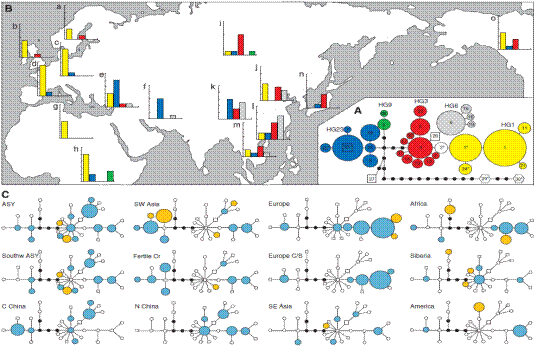When kissing your sweetest pet dogs, I guess most of you aware that they are from the domestication of wolfs. But when it comes to the origins the cute fur balls, I bet you get no clue. As may have been the first animal to be domesticated, to date, in which geographical region the domestication of wolf occurred is still quite controversial.
The earliest fossil carnivores that can be linked with some certainty to canids (wolves, foxes and dogs) are the Eocene Miacids some 56 to 38 million years ago. From the miacids evolved the cat-like (Feloidea) and dog-like (Canoidea) carnivores. The canoid line led from the coyote-sized Mesocyon of the Oligocene (38 to 24 million years ago) to the fox-like Leptocyon and the wolf-like Tomarctus that wandered North America some 10 million years ago.Archaeology has placed the earliest known domestication at potentially 30,000 BC, and with certainty at 7,000 BC. Other evidence suggests that dogs were first domesticated in East Asia.
While, based on the results of maternal inheritable bio-marker mtDNA, the worldwide domesticated dogs are all the descendant of tamed gray wolfs from Asia South of Yangtze River (ASY). But, on the other hand, the evidence from archaeology and autosomal single nucleotide polymorphism (SNP) results support that the origins are Europe or West Asia. According to Ph.D candidate DING Zhao-Li (Kunming Institute of Zoology, the CAS), both the archaeological and the autosomal-SNP datasets suffer from geographical bias, in that they almost totally lack data from ASY. So, it is of necessarity to add new bio-markers to re-evaluate the systematic geography of the origins of the worldwide domesticated dogs which based on the mtDNA dataset.
In their recent research, DING and her colleagues analyzed 14 437 bp of Y-chromosome DNA in the first comprehensive study of Y-chromosome diversity among dogs worldwide, to produce the second global dataset for studies of dog origins. By sampling the Y-chromosome DNA from 151 male dogs cross world, they obtain genetic data for a second independently inherited marker to evaluate the scenario for the origins of domestic dogs suggested by mtDNA data.
The results show that ~50% of dog genetic diversity is shared in a universal gene pool, but whereas most regions harbor only these 50%, ASY has virtually the full range of genetic diversity from which the complete gene pools in other regions may derive. Moreover, by evaluating the substitution rate, which reflects the evolution of DNA, DING assumes that the ancestors of those 151 domesticated dogs are 13-24 grey wolf founders and the backcrossing of domesticated dogs with wild grey wolfs is extremely rare.
In summary, this study initiates the analyses of haplotypic and autosomal genome-wide markers on geographically dense sample collections and systematic archaeological investigations of canid material in neglected regions; offers strong evidence that domestication of wolf occurred primarily and possibly exclusively, in ASY. Both markers also indicate that a large number of wolves, probably several hundred, were domesticated, which suggests that taming of wolf was an important cultural trait in the related human populations.
The article has been published on Heredity (DOI: 10.1038/hdy.2011.114).

Figure 1 Phylogenetic and geographical distribution of haplotypes. (A) Most parsimonious phylogenetic tree. Haplotypes (symbolized by circles for dog, squares for wolf and hexagons for coyote; black dots are hypothetical intermediates) are separated by one substitutional step. The area of the circles is proportional to the frequency of the haplotype among dogs. Haplogroups (see text) are indicated by colour; haplotype 2* cannot be assigned to HG1 or HG3 and therefore white. (B) Geographical distribution of haplogroups. Graphs show number of individuals carrying each haplogroup, colours referring to haplogroups according to (a). Populations: a, Scandinavia; b, Britain; c, Central Europe; d, South Europe; e, Fertile Cr; f, SW Asia East; g, Northern Africa; h, Southern Africa; i, Siberia; j, North China; k, Central China; l, South China; m, Southeast Asia (l and m jointly forming ASY); n, Japan; o, America. For definitions of geographical regions, see Note to Table 1, and Materials and methods. (C) Trees (see a) showing representation (blue, shared with other regions; yellow, unique to the region; white, not present) and frequency (proportional to area) of haplotypes among dogs in geographical regions. Europe C/S, Central and South Europe; SE Asia, Southeast Asia (figure and legend by KIZ).
